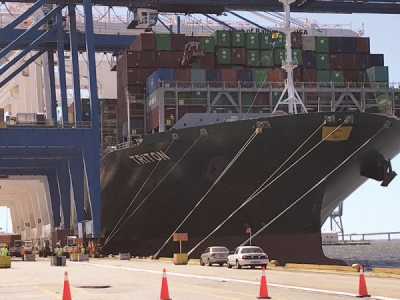
Posted on June 27, 2019
As America’s ports handle larger amounts of cargo from bigger container ships, the ports are in a building boom. But the cost of expanding could get more expensive if a Trump administration plan to impose 25% tariffs on ship-to-shore cranes manufactured only in China are implemented.
The White House is considering adding the cranes to its latest round of proposed tariffs against China, which could total an additional $300 billion. Trump had previously exempted the cranes after port and terminal operators made the case to trade leaders that the cranes bring economic benefits to the U.S. economy, but now they’re back in the tariff crosshairs.
The American Association of Port Authorities and many of its allies were in Washington recently making their case at the U.S. International Trade Commission.

Nagle
“We are deeply disappointed ship-to-shore cranes and other tariff codes that include port equipment are back,” American Association of Port Authorities CEO Kurt Nagle said during testimony. “Tariffs on port equipment will have a detrimental impact on ports and their ability to fund needed infrastructure investments, which will in turn impede U.S. ports’ competitiveness with Canada and Mexico.”
With the expansion of the Panama Canal now finished, and ports planning to spend more than $155 billion dollars in infrastructure improvements by 2024, the number of large ships delivering and picking up cargo is expected to continue increasing. Just last month, the largest cargo ship to visit the Port of Baltimore — the 14,428 industry standard 20-foot-equivalent Triton — delivered thousands of containers while docked for three days before continuing to the Port of New York/New Jersey and the Port of Virginia.
As larger ships call on the ports, larger cranes — which are estimated to cost $12 million dollars a unit — will be needed. The Port of Virginia will spend $1.5 billion on expansions though 2024, dredging the channel and adding infrastructure that includes cranes, so the facility can handle larger ships and load and unload the cargo faster.
“There are no viable alternatives to source these cranes. Rather, the imposition of a 25% duty on such high-cost infrastructure capital equipment has the potential to delay our project schedule and increase the overall project cost, thereby adversely impacting the domestic vendors and the project’s benefit to the national economy,” said Port of Virginia CEO John Reinhardt in testimony to the U.S. Trade Representative.

A Neo-Panamax cargo ship is guided through the Cocoli locks, part of the Panama Canal expansion project in Cocoli, Panama, on June 26, 2017. (Associated Press/Arnulfo Franco)
While opposed to the crane tariffs, AAPA said it is sympathetic to the White House’s desire to level the playing field on trade with China.
“We’re not arguing if China is doing some unfair trade practices, our concern is the tariffs are not only hurting seaports but also the cargo, for example agricultural products. Things like that are really being harmed by these tariffs,” said AAPA Vice President for Government Affairs Susan Monteverde in an interview with Transport Topics. “This would be a cost the port authorities will have to really absorb themselves. We have long-term contracts; port authorities will have to make a decision either not to modernize that part of the port or delay other infrastructure improvements.”
One port with a long-term deal to purchase cranes is the Port of Savannah in Georgia; six have been ordered with a price tag of $70 million. Port Executive Director Griff Lynch said a 25% tariff could have a “substantially negative impact” on work to expand the facility, the state’s top economic development project.

The Zhen Hua 31 heavy-lift ship carrying four super-post-Panamax container cranes sails outside Tacoma, Wash., on March 5, 2019. The cranes were purchased from Shanghai Zhenhua Heavy Industries Co. Ltd. in China by the Northwest Seaport Alliance. There could soon be a 25% tariff on cranes imported from China. (Associated Press/Ted S. Warren)
Just three months ago, the Trump administration proposed contributing more than $130 million to a project now underway to deepen the Savannah harbor channel from 42 to 47 feet. Supporters claim the dredging project will deliver more than $280 million dollars in annual transportation savings to the nation by 2022.
The Port of Charleston is also concerned; it estimates the tariff could add $36 million to the cost of a planned expansion.
Some in Congress are siding with their home-state ports to stop the tariffs. Responding to a plea from the Port of Savannah, Sens. Johnny Isakson and David Perdue of Georgia expressed concern in a letter to U.S. Trade Representative Robert Lighthizer.
“We hope you and your staff will consider the importance of fairness and predictability, so that American businesses can continue to create jobs and increase economic prosperity,” the senators wrote.
Source: ttnews.com





